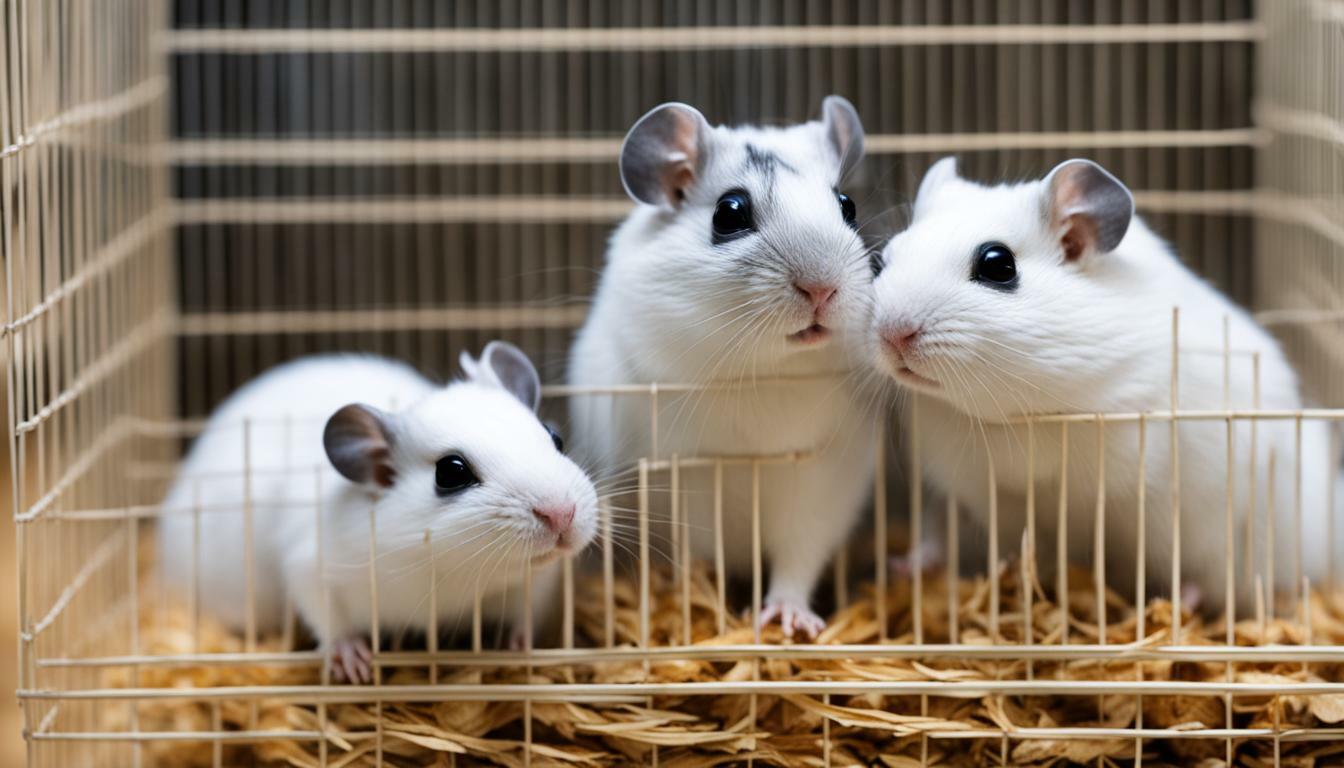Black and white gerbils have long been a subject of curiosity for gerbil enthusiasts, leading many to wonder if they are rare in the gerbil community.
Key Takeaways:
- Black and white gerbils are not considered rare in the world of gerbil colors.
- The most common color among gerbils is golden agouti.
- There are several other colors and patterns available through selective breeding, including blue, lilac, white, and black gerbils.
- White gerbils can have pink or red eyes, but they are not considered albinos.
- The rarity of gerbil colors and patterns can vary depending on genetics, breeding, location, and availability of breeders.
The Availability of Black and White Gerbils
While black and white gerbils may not be as common as golden agouti, their availability can still vary depending on factors such as location and the presence of breeders specializing in unique color variations. Gerbil enthusiasts who are specifically interested in acquiring black and white gerbils might need to do some research and potentially reach out to breeders who focus on producing these particular color patterns.
It is important to note that the rarity of black and white gerbils does not necessarily mean they are extremely difficult to find. There are breeders who work diligently to produce and offer different color variations, including black and white gerbils, to meet the demand of gerbil enthusiasts. However, due to the specific genetic traits required to produce black and white coat patterns, these gerbils may still be more scarce compared to the more common golden agouti gerbils.
If you are interested in owning a black and white gerbil, it is recommended to connect with gerbil breeders and organizations to inquire about their availability. Some breeders may have waiting lists or limited stock, so it is advisable to plan ahead and be patient in your search for these unique gerbil colors. Additionally, attending gerbil shows and exhibitions can also provide opportunities to connect with breeders who specialize in rare color variations, such as black and white gerbils.
| Gerbil Color | Availability |
|---|---|
| Golden Agouti | Common |
| Black and White | Scarce |
| Blue | Rare |
| Lilac | Rare |
As the table shows, black and white gerbils fall under the “scarce” category in terms of availability. This does not mean they are impossible to find, but rather they may require some extra effort and patience to locate. It is important to remember that gerbil breeding and availability can vary depending on location, so it is always recommended to explore local resources and connect with the gerbil community in your area to get the most accurate information on the availability of black and white gerbils.
The Diversity of Gerbil Colors
Gerbil breeders have pushed the boundaries of color genetics, resulting in a wide array of colors and patterns, including the captivating black and white gerbils. While the most common color among gerbils is golden agouti, there are now several other uncommon colors and patterns available through selective breeding.
Some of the unique color variations that breeders have achieved include blue, lilac, white, and black gerbils. These colors can vary in intensity and can be combined with other patterns to create visually striking gerbils that stand out from the crowd.
Black and White Gerbil Breed Rarity
One particular color variation that has captured the attention of gerbil enthusiasts is the black and white gerbil. Characterized by their distinct black and white coat pattern, these gerbils have become sought-after by those looking for something a little different.
It is important to note that the rarity of black and white gerbils, as well as other color variations, can vary depending on genetics and breeding practices. Factors such as the availability of breeders specializing in unique color variations and the location can play a role in determining the rarity of certain gerbil breeds.
In conclusion, the world of gerbil colors is full of diversity and fascination. Gerbil breeders have successfully produced a wide range of colors and patterns through selective breeding, including the visually striking black and white gerbils. While the rarity of these unique color variations may vary, their desirability among gerbil enthusiasts remains high.
| Color Variation | Description |
|---|---|
| Blue | Distinct blue-gray coat color |
| Lilac | Pale purple coat color |
| White | White coat color with pink or red eyes |
| Black and White | Distinct black and white coat pattern |
Understanding Black and White Gerbil Traits
Black and white gerbils exhibit a striking contrast of colors, with their fur featuring a combination of black and white patches that make them truly eye-catching. The black patches can appear on various parts of their bodies, including their back, head, and tail, while the white patches complement these areas, creating a unique and visually appealing pattern.
One of the fascinating traits of black and white gerbils is their coat pattern. Their fur can display different variations, such as piebald or spotted patterns, where the black and white patches are evenly distributed or randomly scattered across their bodies. This adds to their individuality, making each gerbil distinct from the others within its litter.
Additionally, black and white gerbils can have different eye colors. While the majority of gerbils have dark eyes, gerbils with white patches may have pink or red eyes due to the lack of pigment in those areas. It’s important to note that gerbils with pink or red eyes are not considered albinos, as albinos lack all pigmentation throughout their bodies.
Understanding the traits of black and white gerbils contributes to our appreciation of their rarity and uniqueness within the gerbil color spectrum. Their striking colors, distinctive patterns, and occasional eye color variations make them sought-after additions to gerbil collections worldwide.
| Traits | Description |
|---|---|
| Coat Pattern | Black and white gerbils can exhibit piebald or spotted coat patterns, with patches of black and white fur distributed across their bodies. |
| Eye Color | While most gerbils have dark eyes, gerbils with white patches may have pink or red eyes due to the lack of pigmentation in those areas. |
| Uniqueness | The combination of their striking colors and distinct coat patterns make black and white gerbils unique and highly desirable among gerbil enthusiasts. |
The Genetics behind Black and White Gerbils
The distinctive black and white coloration in gerbils is the result of specific genetic combinations passed down through generations of breeding. Breeders carefully select gerbils with desired color traits, such as those carrying the genes for black and white coat patterns, to produce offspring with this unique appearance.
Black and white gerbils typically have a gene called piebald, which causes patches of black and white fur. This gene is inherited from both parents, and its expression determines the amount and distribution of black and white on the gerbil’s coat. The piebald gene is responsible for creating the striking contrast between the two colors in these gerbils.
Other genes, such as those for agouti, determine the base color of the gerbil’s fur. The agouti gene can produce colors ranging from golden agouti to dark agouti, providing the foundation for the black and white pattern. When combined with the piebald gene, it results in the characteristic black and white coat.
| Genes | Appearance |
|---|---|
| Piebald + Agouti | Black and white coat |
| No Piebald + Agouti | No black and white coat |
It’s important to note that the rarity of black and white gerbils can vary depending on the availability of breeders specializing in these color variations. Additionally, the expression of certain genes and the presence of other genetic factors can influence the occurrence and frequency of black and white gerbils in specific breeding lines.
In conclusion, the black and white coloration exhibited by gerbils is a visually striking trait that is the result of specific genetic combinations. While not considered rare in the world of gerbil breeding, these unique gerbils are sought after by enthusiasts due to their distinctive appearance. Through careful breeding and selection, breeders aim to produce gerbils with desirable color variations, including black and white coat patterns.
Black and White Gerbils vs. Albinos
It is important to note that white gerbils with black patches are not the same as albinos, as their eye color and genetic makeup differ. While white gerbils can have pink or red eyes, true albinos have a complete lack of pigmentation, resulting in red or pink eyes, pale skin, and white hair or fur. In contrast, black and white gerbils possess distinct coat patterns with a combination of black and white fur, creating a visually striking appearance.
The genetic makeup of black and white gerbils also differs from that of albinos. Black and white gerbils inherit specific genes that control the distribution and coloration of their fur, creating the unique pattern seen in their coats. These gerbils have a genetic makeup that allows for the expression of both black and white color pigments, resulting in their distinct coat patterns.
It is fascinating to observe the contrast between black and white gerbils and albinos, highlighting the diversity within the gerbil community. While albinos are notable for their lack of pigmentation and striking eye color, black and white gerbils captivate with their distinct coat patterns, showcasing the intricate genetics behind their appearance.
| Characteristics | Black and White Gerbils | Albinos |
|---|---|---|
| Fur Color | Black and White | White |
| Eye Color | Varies, but not red or pink | Red or Pink |
| Genetic Makeup | Specific genes allow for expression of both black and white pigments | Lack of pigmentation due to genetic mutation |
Overall, black and white gerbils and albinos represent distinct color variations within the gerbil population. While albinos are characterized by their lack of pigmentation and pink or red eyes, black and white gerbils possess a unique coat pattern with a combination of black and white fur. Understanding these differences adds to the fascination and appreciation for the diverse colors and patterns that can be found among gerbils.
Value and Desirability of Black and White Gerbils
Black and white gerbils are highly sought-after by gerbil enthusiasts due to their captivating appearance and the rarity they offer within the gerbil color spectrum. While the most common color among gerbils is golden agouti, these unique black and white gerbils stand out with their striking contrast and beautiful markings. Their black and white coat patterns create a visually appealing aesthetic that is highly desired by gerbil owners and breeders alike.
These gerbils add a touch of elegance and sophistication to any gerbil collection. Their distinct coloration is not only visually appealing but also represents a sense of rarity and exclusivity. As a result, black and white gerbils often become the center of attention when displayed alongside other color variations, making them a valuable addition to any gerbil enthusiast’s collection.
Their desirability is also influenced by their relative rarity within the gerbil breeding and ownership community. While black and white gerbils can be found, their availability may vary depending on location and the presence of breeders specializing in unique color variations. This scarcity only adds to their allure, making them highly coveted by those seeking a truly unique and eye-catching gerbil for their collection.
| Advantages of Black and White Gerbils: | Disadvantages of Black and White Gerbils: |
|---|---|
|
|
Factors Influencing Black and White Gerbil Rarity
The rarity of black and white gerbils can be influenced by various factors, including the intricacies of genetics, the selective breeding efforts of dedicated gerbil enthusiasts, and the availability of specialized breeders. When it comes to gerbil colors, the genetic makeup plays a crucial role in determining the likelihood of certain colorations appearing in a gerbil’s coat. Breeding for specific traits, such as the black and white pattern, requires careful selection of parent gerbils with the desired genes.
Selective breeding is a time-consuming process that involves strategically pairing gerbils with the desired traits to increase the chances of producing offspring with those traits. Breeders who focus on producing black and white gerbils dedicate their time and resources to refine breeding techniques and establish lines that consistently produce these unique colors. The meticulous efforts of these dedicated enthusiasts contribute to the controlled availability of black and white gerbils.
Additionally, the availability of specialized breeders who specialize in breeding and selling unique color variations, including black and white gerbils, can impact their rarity. These breeders dedicate their expertise to producing and promoting gerbils with unusual color patterns, making them more accessible to interested individuals. However, the rarity of black and white gerbils can also be influenced by geographical location, as some areas may have a higher concentration of breeders specializing in these specific color variations.
| Factors Influencing Black and White Gerbil Rarity |
|---|
| Intricacies of Genetics |
| Selective Breeding Efforts |
| Availability of Specialized Breeders |
| Geographical Location |
In conclusion, black and white gerbils are not considered rare in the world of gerbil colors. However, their availability may vary depending on the efforts of dedicated breeders and geographical location. The intricacies of genetics and the selective breeding efforts of enthusiasts contribute to the controlled availability and uniqueness of these color variations. By understanding the factors that influence the rarity of black and white gerbils, gerbil enthusiasts can better appreciate the beauty and value that these unique gerbils bring to the world of pet ownership.
The Popularity of Black and White Gerbils
Black and white gerbils have gained significant popularity among gerbil enthusiasts, contributing to the rich tapestry of colors and patterns within the gerbil community. While they may not be considered rare in the world of gerbil colors, their unique appearance and striking contrast make them highly sought-after by breeders and owners alike.
These gerbils exhibit beautiful coat patterns, with a combination of black and white fur that creates distinct markings. The contrast between the two colors makes them visually appealing and captivating to observe. Their rarity stems from the fact that they are not as common as the traditional golden agouti color, making them a desired addition to any gerbil collection.
One of the fascinating aspects of black and white gerbils is their ability to showcase the diversity of gerbil colors. Through selective breeding techniques, breeders have been able to produce a wide range of unique color variations, including blue, lilac, white, and black gerbils. This diversity adds to the allure of black and white gerbils, as they stand out among the various color possibilities.
| Color | Eye Color |
|---|---|
| Black and White | Varies (not albino) |
| Blue | Black |
| Lilac | Black |
| White | Pink or red |
It is essential to note that the rarity of black and white gerbils can vary depending on location and the availability of breeders specializing in unique color variations. However, their popularity continues to grow as more people appreciate their distinct beauty and charm within the gerbil community.
The Fascination with Black and White Gerbils
The allure of black and white gerbils lies in their stunning appearance and the intrigue surrounding their rarity within the world of gerbil colors. While black and white gerbils are not considered rare in comparison to the most common color, golden agouti, they still hold a special place in the hearts of gerbil enthusiasts. These unique gerbils exhibit a striking contrast between their dark and light fur, creating a visually captivating display that sets them apart from other color variations.
Black and white gerbils, with their distinct coat patterns and eye-catching colors, are highly sought after by those looking to add a touch of uniqueness to their gerbil collection. Breeders and owners appreciate the challenge of producing and caring for these uncommon gerbils, further adding to their appeal. However, it is important to note that the availability of black and white gerbils can vary depending on location and the breeders specializing in unique color variations.
Through selective breeding and careful genetic manipulation, breeders have been able to produce an array of colors and patterns in gerbils. Black and white gerbils are just one example of the diverse range of color variations available. Other colors, such as blue, lilac, and white, can also be found in the world of gerbil breeding. It is fascinating to observe the different coat patterns and eye colors that can be achieved through these breeding efforts.
| Gerbil Color | Distinct Features |
|---|---|
| Black and White | Striking contrast between dark and light fur |
| Blue | Rich blue-gray coat |
| Lilac | Pale purple-gray fur |
| White | Pure white fur with the possibility of pink or red eyes |
While black and white gerbils may not be considered rare in the grand scheme of gerbil colors, their unique appearance and relative scarcity make them highly desirable among gerbil enthusiasts. The challenge of obtaining these uncommon gerbils and the aesthetic pleasure they bring add to their appeal. Whether you’re a serious breeder or an avid gerbil lover, black and white gerbils are sure to capture your attention and leave you marveling at the beauty of these remarkable creatures.
Conclusion
In conclusion, while black and white gerbils are not considered exceptionally rare, they remain highly sought-after by gerbil enthusiasts due to their captivating appearance and the unique touch of rarity they bring to the world of gerbil colors. Gerbil breeding has led to the creation of various color variations, including blue, lilac, white, and black gerbils, each with its own aesthetic appeal.
It is important to note that the availability and rarity of these color variations may vary depending on location and the availability of breeders specializing in unique gerbil colors. Nonetheless, black and white gerbils continue to hold a special place among gerbil owners, attracting attention for their distinctive coat patterns, eye colors, and overall charm.
While white gerbils may have pink or red eyes, they should not be confused with albinos as they possess different genetic characteristics. The genetics behind black and white gerbils are complex and intriguing, with breeders employing selective breeding strategies to achieve desired outcomes.
Overall, the fascination with black and white gerbils stems from their relative rarity in comparison to the most common golden agouti color, as well as their visually striking appearance. These unique gerbils not only add diversity to gerbil populations but also serve as a testament to the beauty and intrigue that can be found in the world of gerbil colors.
FAQ
Are black and white gerbils considered rare?
No, black and white gerbils are not considered rare in the world of gerbil colors. While the most common color is golden agouti, there are several other colors and patterns available through selective breeding.
What other colors and patterns are available in gerbils?
Some of the color variations include blue, lilac, white, and black gerbils. The white gerbils can have pink or red eyes, but they are not considered albinos. These colors and patterns can vary depending on genetics and breeding.
How rare are black and white gerbils?
The rarity of gerbil colors and patterns can vary depending on location and availability of breeders. While black and white gerbils may not be as common as golden agouti, their rarity can differ from one breeding community to another.
What sets black and white gerbils apart from other color variations?
Black and white gerbils have distinct coat patterns that make them visually striking. They possess unique traits and characteristics that make them stand out among other gerbil color variations.
What is the genetics behind black and white gerbils?
Producing black and white gerbils involves specific genetic factors. Certain genes contribute to the expression of these color patterns, and breeders employ selective breeding strategies to achieve desired outcomes.
How do black and white gerbils differ from albinos?
While white gerbils can have pink or red eyes, they are not considered albinos. Black and white gerbils possess different genetic characteristics and coat patterns compared to true albinos.
How desirable are black and white gerbils among gerbil enthusiasts?
Black and white gerbils hold value and desirability among gerbil enthusiasts due to their unique coloration and visual appeal. They are sought-after for their rarity and the aesthetic interest they generate.
What factors can influence the rarity of black and white gerbils?
The rarity of black and white gerbils can be influenced by factors such as genetics, breeding practices, and the availability of breeders specializing in unique color variations.
How popular are black and white gerbils among gerbil owners and breeders?
Black and white gerbils are popular among gerbil owners and breeders due to their distinctiveness and relative rarity. They contribute to the overall diversity of gerbil populations and are highly valued by enthusiasts.
What fascinates people about black and white gerbils?
People are fascinated by black and white gerbils due to their unique coloration and the intrigue that comes with their relative rarity. They evoke aesthetic appeal and captivate the interest of gerbil enthusiasts.




